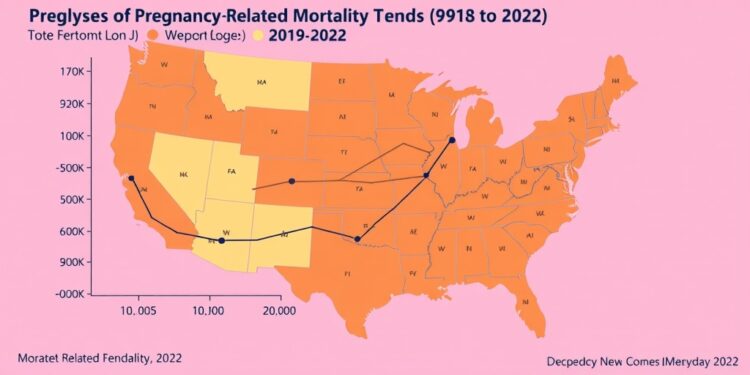In a pivotal and concerning analysis of pregnancy-related deaths in the United States, researchers have uncovered alarming trends between 2018 and 2022. This cross-sectional study sheds light on the increasing rates of maternal mortality during this period, which not only raised eyebrows among health professionals but also highlighted significant disparities based on geography as well as race and ethnicity. These findings emphasize the crucial need for a comprehensive public health approach to tackle the burgeoning issue of maternal mortality in the U.S.
The study’s data presents a stark picture, revealing that maternal death rates are not uniform across the country. Variability is evident from state to state, indicating that systemic issues may be at play, contributing to these health disparities. For instance, certain states report rates that are much higher than the national average, suggesting localized crises that may require targeted interventions. These disparities serve as a wake-up call for policymakers and health officials, stressing that maternal health should be treated with the utmost urgency as a public health priority.
Diving deeper into the demographics, the study reveals significant differences in maternal mortality rates across racial and ethnic lines. Women of color face distinctly higher risks during pregnancy and childbirth, showcasing an unsettling reality of healthcare accessibility and quality. This inequality not only raises moral questions but also suggests a broader cultural issue where systemic racism and bias in the healthcare system may contribute to these dire outcomes. Raising awareness of such disparities is critical for driving change in maternal healthcare policies.
The nuances of maternal mortality rates extend beyond mere statistics. The consequences of these deaths ripple through families and communities, often leaving behind children who lose their primary caregivers. The emotional and financial burdens can be enormous, affecting the fabric of society at large. This study underscores the human cost of maternal mortality, urging stakeholders to consider the wider implications of their findings.
Public health experts argue that combating maternal mortality rates has become more important than ever, especially in light of the COVID-19 pandemic’s impact on healthcare systems. The pandemic has disrupted essential services, and the repercussions on maternal health are profound. It has become increasingly important to ensure that pregnant individuals receive the care they need, regardless of their circumstances. The intersection of maternal health and public health has never been more apparent, and efforts must be mobilized to address these challenges urgently.
Moreover, the United States’ maternal mortality crisis raises profound questions regarding healthcare policies and funding allocations. Critics highlight a historic lack of investment in women’s health, which has hampered progress in preventing maternal deaths. Advocates argue for increased funding and resources to be directed specifically toward maternal health initiatives that can effectively address these alarming trends. Policymakers must act decisively to prioritize maternal health in a way that ensures equity and accessibility for all women.
Another aspect of this analysis involves the importance of data collection and transparency regarding maternal mortality. Accurate data is crucial for understanding the scope of the problem and effectively targeting interventions. The lack of consistent data reporting across states complicates the ability to track progress or understand the specific challenges faced by different populations. Establishing standardized measures for maternal health data could facilitate more effective public health strategies and interventions.
Research into the underlying factors contributing to these disparities is vital. Factors such as socioeconomic status, access to healthcare, education, and social support systems must be considered in this complex issue. By dissecting these contributing factors, stakeholders can develop a multifaceted approach to combat maternal mortality and ensure that all women have access to safe and respectful care during pregnancy and childbirth.
The findings of this study are particularly timely, as discussions around healthcare reform and maternal health are gaining momentum. Advocates are pushing for systemic changes, encouraging politicians to prioritize maternal health initiatives in legislative agendas. Expanding Medicaid coverage for perinatal care, improving access to postpartum services, and ensuring culturally competent care are among the critical reforms being discussed. The call to action is clear: comprehensive changes are necessary to save lives.
The insights presented in this cross-sectional study are not merely numbers on a page; they represent human lives and experiences that cannot be overlooked. As the research highlights the growing maternal mortality crisis, it acts as a catalyst for change. The urgency to address these disparities cannot be understated, and collective action from public health officials, policymakers, and communities is essential to ensure that all women have the support needed during one of the most vulnerable periods of their lives.
As this pivotal study gains traction within the medical community and beyond, we must remain vigilant in our commitment to improving maternal health outcomes. The alarming trends are a reminder of the work that still needs to be done, as well as an invitation to engage in meaningful dialogue and action. The implications of this study extend far beyond academic circles; they reach into our communities and impact families across the nation. The quest for equity in maternal health continues, demanding our attention and action.
In conclusion, the data surrounding pregnancy-related deaths in the U.S. underscores the urgent need for reform, advocacy, and awareness surrounding maternal health issues. With its alarming figures and poignant insights into how race, state, and systemic factors intersect to influence maternal mortality, this study serves as both a warning and a guide for future efforts. The time for action is now, and a collective commitment to improving maternal health can pave the way for brighter futures for mothers and families across the country.
Subject of Research: Maternal mortality rates in the U.S. from 2018 to 2022
Article Title: Increasing Maternal Mortality Rates: A Critical Public Health Issue
News Publication Date: October 2023
Web References: Link to study
References: Link to references
Image Credits: © 2023 JAMA Network Open
Keywords: Maternal Mortality, Public Health, Health Disparities, Pregnancy, Racial Inequality, Healthcare Policy




